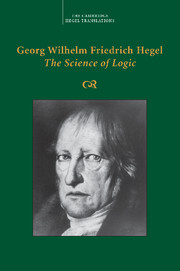Chapter 2 - Actuality
Published online by Cambridge University Press: 30 September 2021
Summary
The absolute is the unity of inner and outer as a first implicitly existent unit. The exposition appeared as an external reflection which, for its part, has the immediate as something it has found, but it equally is its movement and the reference connecting it to the absolute and, as such, it leads it back to the latter, determining it as a mere “way and manner.” But this “way and manner” is the determination of the absolute itself, namely its first identity or its mere implicitly existent unity. And through this reflection, not only is that first in-itself posited as essenceless determination, but, since the reflection is negative self-reference, it is through it that the in-itself becomes a mode in the first place. It is this reflection that, in sublating itself in its determinations and as a movement which as such turns back upon itself, is first truly absolute identity and, at the same time, the determining of the absolute or its modality. The mode, therefore, is the externality of the absolute, but equally so only its reflection into itself; or again, it is the absolute's own manifestation, so that this externalization is its immanent reflection and therefore its being in-and-for-itself.
So, as the manifestation that it is nothing, that it has no content, save to be the manifestation of itself, the absolute is absolute form. Actuality is to be taken as this reflected absoluteness. Being is not yet actual; it is the first immediacy; its reflection is therefore becoming and transition into an other; or its immediacy is not being-in-and-for-itself. Actuality also stands higher than concrete existence. It is true that the latter is the immediacy that has proceeded from ground and conditions, or from essence and its reflection. In itself or implicitly, it is therefore what actuality is, real reflection; but it is still not the posited unity of reflection and immediacy. Hence concrete existence passes over into appearance as it develops the reflection contained within it. It is the ground that has foundered to the ground; its determination, its vocation, is to restore this ground, and therefore it becomes essential relation, and its final reflection is that its immediacy be posited as immanent reflection and conversely.
- Type
- Chapter
- Information
- Georg Wilhelm Friedrich Hegel: The Science of Logic , pp. 477 - 488Publisher: Cambridge University PressPrint publication year: 2010

